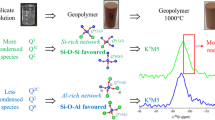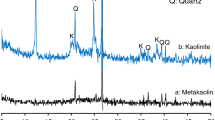Abstract
Effective and efficient recovery, storage, and reuse of heat, together with renewable energy, play an indispensable role in decarbonising the built environment. Thermochemical energy storage materials possess the highest volumetric energy density compared to latent and sensible heat storage materials under similar conditions. However, conventional thermochemical energy storage materials face several challenges including high cost, low sustainability, and limited heating power. Alkali-activated metakaolin (geopolymer) containing alkali aluminosilicate hydrates (N-A-S-H) has been shown to have a considerable thermochemical heat storage capacity at medium temperatures (below 400 ℃) but is less efficient at low-temperatures (<200 ℃). Here we investigated a salt impregnation method to form geopolymer composites for improving their thermochemical heat storage capacity at low charging temperature. More specifically, the effect of CaCl2-impregnation on the composition of the composites was examined with X-Ray Diffractometry and Fourier transform infrared (FTIR) spectroscopy. The dehydration enthalpy and volumetric energy density of the composites were assessed with differential scanning calorimetry (DSC), while dynamic water sorption (DVS) was used to study their water cyclic water sorption capacity. It was shown that short-time salt-impregnation can improve the heat storage capacity of the geopolymers, while a prolonged exposure to the salt solution can have adverse effects.
Access this chapter
Tax calculation will be finalised at checkout
Purchases are for personal use only
Similar content being viewed by others
References
Kaufmann, J., Winnefeld, F.: Seasonal heat storage in calcium sulfoaluminate based hardened cement pastes – experiences with different prototypes. J. Energy Storage 25, 100850 (2019)
Tatsidjodoung, P., Le Pierrès, N., Luo, L.: A review of potential materials for thermal energy storage in building applications. Renew. Sustain. Energy Rev. 18, 327–349 (2013)
André, L., Abanades, S., Flamant, G.: Screening of thermochemical systems based on solid-gas reversible reactions for high temperature solar thermal energy storage. Renew. Sustain. Energy Rev. 64, 703–715 (2016)
Zhao, Q., et al.: Optimization of thermochemical energy storage systems based on hydrated salts: a review. Energy Build. 244, 111035 (2021)
Cot-Gores, J., Castell, A., Cabeza, L.F.: Thermochemical energy storage and conversion: a-state-of-the-art review of the experimental research under practical conditions. Renew. Sustain. Energy Rev. 16(7), 5207–5224 (2012)
Humphries, T.D., et al.: Dolomite: a low cost thermochemical energy storage material. J. Mater. Chem. A 7(3), 1206–1215 (2019)
Wang, K., et al.: A review for Ca(OH)2/CaO thermochemical energy storage systems. J. Energy Storage 50, 104612 (2022)
Yang, Y., et al.: Thermochemical heat storage and optical properties of red mud/Mn co-doped high alumina cement-stabilized carbide slag in CaO/CaCO3 cycles. Fuel Process. Technol. 236, 107419 (2022)
Johannes, K., et al.: Design and characterisation of a high powered energy dense zeolite thermal energy storage system for buildings. Appl. Energy 159, 80–86 (2015)
Ndiaye, K., Ginestet, S., Cyr, M.: Experimental evaluation of two low temperature energy storage prototypes based on innovative cementitious material. Appl. Energy 217, 47–55 (2018)
Chen, B., et al.: Investigation on ettringite as a low-cost high-density thermochemical heat storage material: thermodynamics and kinetics. Sol. Energy Mater. Sol. Cells 221, 110877 (2021)
Alonso, M.C., et al.: Calcium aluminate based cement for concrete to be used as thermal energy storage in solar thermal electricity plants. Cem. Concr. Res. 82, 74–86 (2016)
Lavagna, L., et al.: Cementitious composite materials for thermal energy storage applications: a preliminary characterization and theoretical analysis. Sci. Rep. 10(1), 12833 (2020)
Ke, X., Baki, V.A.: Assessing the suitability of alkali-activated metakaolin geopolymer for thermochemical heat storage. Microporous Mesoporous Mater. 325, 111329 (2021)
Bell, J.L., et al.: X-Ray pair distribution function analysis of a metakaolin-based, KAlSi2O6·5.5H2O inorganic polymer (geopolymer). J. Mater. Chem. 18(48), 5974–5981 (2008)
Gong, W., et al.: Geopolymer concretes for energy storage applications. United States of America (2020)
Ke, X., Baki, V.A.: Assessing the suitability of alkali-activated metakaolin geopolymer for thermochemical heat storage. Microporous Mesoporous Mater. 325, 111329 (2021)
Xueling, Z., et al.: Heat storage performance analysis of ZMS-Porous media/CaCl2/MgSO4 composite thermochemical heat storage materials. Sol. Energy Mater. Sol. Cells 230, 111246 (2021)
Walsh, S., et al.: Assessing the dynamic performance of thermochemical storage materials. Energies 13 (2020). https://doi.org/10.3390/en13092202
Medri, V., et al.: Metakaolin-based geopolymer beads: production methods and characterization. J. Clean. Prod. 244, 118844 (2020)
Papa, E., et al.: Geopolymer-hydrotalcite hybrid beads by ionotropic gelation. Appl. Clay Sci. 215, 106326 (2021)
Walkley, B., et al.: Thermodynamic properties of sodium aluminosilicate hydrate (N–A–S–H). Dalton Trans. 50(39), 13968–13984 (2021)
Olvianas, M., Widiyatmoko, A., Petrus, H.T.B.M.: IR spectral similarity studies of geothermal silica-bentonite based geopolymer. AIP Conf. Proc. 1887(1), 020015 (2017)
Jaya, N.A., et al.: Correlation between pore structure, compressive strength and thermal conductivity of porous metakaolin geopolymer. Constr. Build. Mater. 247, 118641 (2020)
Ndiaye, K., Cyr, M., Ginestet, S.: Development of a cementitious material for thermal energy storage at low temperature. Constr. Build. Mater. 242, 118130 (2020)
Acknowledgement
This research was funded by the UK Engineering and Physical Sciences Research Council (EPSRC) through Grant EP/W010828/1.
Author information
Authors and Affiliations
Corresponding author
Editor information
Editors and Affiliations
Rights and permissions
Copyright information
© 2023 The Author(s), under exclusive license to Springer Nature Switzerland AG
About this paper
Cite this paper
Skevi, L., Ke, X., Elvins, J., Ding, Y. (2023). The Effect of Salt-Impregnation on Thermochemical Properties of a Metakaolin Geopolymer Composite for Thermal Energy Storage. In: Jędrzejewska, A., Kanavaris, F., Azenha, M., Benboudjema, F., Schlicke, D. (eds) International RILEM Conference on Synergising Expertise towards Sustainability and Robustness of Cement-based Materials and Concrete Structures. SynerCrete 2023. RILEM Bookseries, vol 43. Springer, Cham. https://doi.org/10.1007/978-3-031-33211-1_110
Download citation
DOI: https://doi.org/10.1007/978-3-031-33211-1_110
Published:
Publisher Name: Springer, Cham
Print ISBN: 978-3-031-33210-4
Online ISBN: 978-3-031-33211-1
eBook Packages: EngineeringEngineering (R0)




